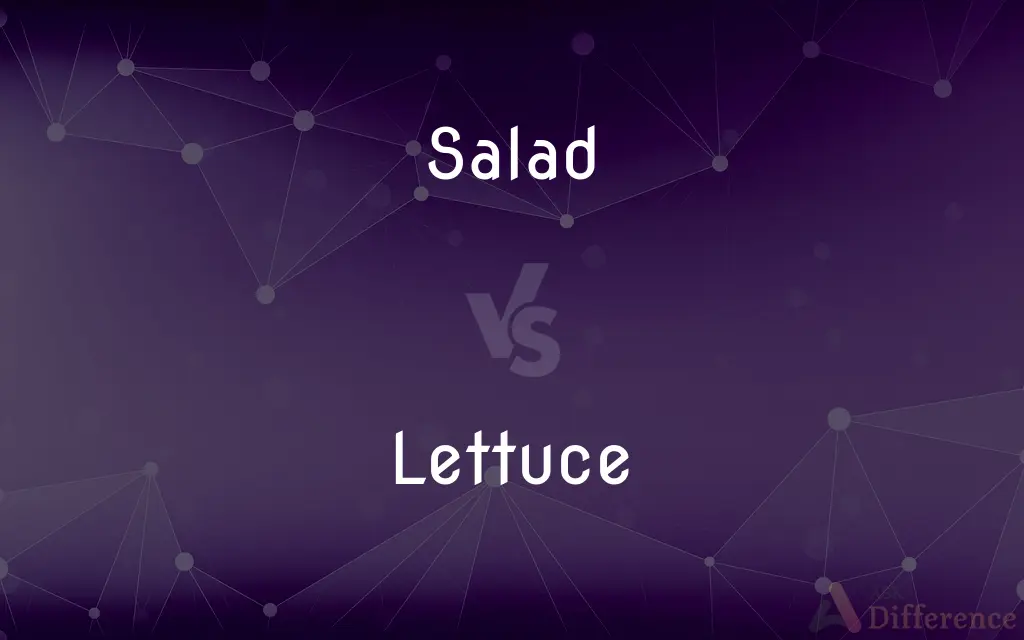Salad vs. Lettuce — What's the Difference?
By Tayyaba Rehman & Maham Liaqat — Updated on May 3, 2024
Salad is a dish composed of mixed ingredients, often including greens like lettuce, which is a specific leafy green vegetable used primarily in salads.

Difference Between Salad and Lettuce
Table of Contents
ADVERTISEMENT
Key Differences
Salad is a diverse dish that can include a variety of ingredients such as vegetables, fruits, nuts, and dressings, while lettuce is a specific type of leaf vegetable, commonly used as a primary component in many salads.
In terms of preparation, salads can be either complex, with multiple ingredients and dressings, or simple, whereas lettuce can be used either as a whole leaf or chopped, serving as a base for salads or a component in sandwiches.
Salads can vary widely based on their ingredients; they can be rich in vitamins, minerals, and fiber, whereas lettuce primarily provides vitamin A, vitamin K, and folate with a high water content.
Lettuce comes in various forms, such as iceberg, romaine, and butterhead, each with unique textures and flavors, which are often chosen based on the type of salad being prepared.
Cultural significance also differs; salads are featured widely across various cuisines, adapting to regional tastes and available ingredients, while lettuce has been a staple in both Western and Mediterranean diets for centuries.
ADVERTISEMENT
Comparison Chart
Definition
A dish made of mixed ingredients, often including greens, vegetables, and dressings.
A leafy green vegetable commonly used in salads and sandwiches.
Types
Fruit salad, vegetable salad, mixed salad, Caesar salad, Greek salad.
Iceberg, romaine, butterhead, leaf lettuce, arugula.
Nutritional Value
Varies widely; can be high in vitamins, minerals, and fiber depending on ingredients.
Generally low in calories, high in vitamin A and K, and good source of folate.
Preparation Methods
Can be tossed, layered, or dressed; ingredients can be raw or cooked.
Typically eaten raw; can be chopped, torn, or used whole.
Usage in Cuisine
Used globally in various forms adapting to regional ingredients and tastes.
Primarily used in Western and Mediterranean cuisines.
Compare with Definitions
Salad
A mixture of various edible ingredients, typically including vegetables, fruits, and dressing.
A Caesar salad includes romaine lettuce, croutons, and Caesar dressing.
Lettuce
A leafy green vegetable that is a common ingredient in salads.
Iceberg lettuce is popular for its crunchy texture.
Salad
May include cooked ingredients like pasta, chicken, or seafood.
A seafood salad might contain shrimp and scallops.
Lettuce
Mostly consumed raw but can be briefly cooked for dishes like wilted lettuce salads.
Lightly sautéed romaine lettuce can be used in warm salads.
Salad
Often served as a side dish or a main course, depending on the ingredients.
A chicken salad can serve as a fulfilling main course.
Lettuce
Contains high water content, making it hydrating but low in calories.
Butterhead lettuce has a soft texture and a sweet flavor.
Salad
Served either chilled or at room temperature to enhance flavor.
A summer salad with fresh greens and fruits is served chilled.
Lettuce
Can be used whole, shredded, or chopped, depending on the dish.
Shredded lettuce is often used in tacos.
Salad
Can be customized to be vegetarian, vegan, or non-vegetarian.
A Greek salad is vegetarian and includes feta cheese and olives.
Lettuce
Has several varieties, each with distinct flavors and uses.
Romaine lettuce is ideal for Caesar salads because of its robust leaves.
Salad
A salad is a dish consisting of mixed pieces of food, typically with at least one raw ingredient. They are often dressed, and typically served at room temperature or chilled, though some can be served warm.
Lettuce
Lettuce (Lactuca sativa) is an annual plant of the daisy family, Asteraceae. It is most often grown as a leaf vegetable, but sometimes for its stem and seeds.
Salad
A dish of raw leafy green vegetables, often tossed with pieces of other raw or cooked vegetables, fruit, cheese, or other ingredients and served with a dressing.
Lettuce
Any of various plants of the genus Lactuca of the composite family, especially L. sativa, cultivated for its edible leaves.
Salad
The course of a meal consisting of this dish.
Lettuce
The leaves of L. sativa, used especially in salads.
Salad
A cold dish of chopped vegetables, fruit, meat, fish, eggs, or other food, usually prepared with a dressing, such as mayonnaise.
Lettuce
(Slang) Paper money.
Salad
A green vegetable or herb used in salad, especially lettuce.
Lettuce
An edible plant, Lactuca sativa and its close relatives, having a head of green and/or purple leaves.
Salad
A varied mixture
"The Declaration of Independence was ... a salad of illusions" (George Santayana).
Lettuce
(uncountable) The leaves of the lettuce plant, eaten as a vegetable; as a dish often mixed with other ingredients, dressing etc.
I’ll have a ham sandwich with lettuce and tomato.
Salad
A food made primarily of a mixture of raw or cold ingredients, typically vegetables, usually served with a dressing such as vinegar or mayonnaise.
Chicken salad
We'd like a couple of cheese salads and two Pepsis, please.
Lettuce
United States paper currency; dollars.
Twenty dollars an hour? That's a lot of lettuce!
Salad
A raw vegetable of the kind used in salads.
Lettuce
A strong yellow-green colour, like that of lettuce (also called lettuce green).
Salad
(idiomatic) Any varied blend or mixture.
Lettuce
Weed or marijuana
Salad
A preparation of vegetables, as lettuce, celery, water cress, onions, etc., usually dressed with salt, vinegar, oil, and spice, and eaten for giving a relish to other food; as, lettuce salad; tomato salad, etc.
Leaves eaten raw are termed salad.
Lettuce
Long hair, as worn by an exemplar of bro culture
Salad
A dish composed of chopped meat or fish, esp. chicken or lobster, mixed with lettuce or other vegetables, and seasoned with oil, vinegar, mustard, and other condiments; as, chicken salad; lobster salad.
Lettuce
A composite plant of the genus Lactuca (Lactuca sativa), the leaves of which are used as salad. Plants of this genus yield a milky juice, from which lactucarium is obtained. The commonest wild lettuce of the United States is Lactuca Canadensis.
Salad
Food mixtures either arranged on a plate or tossed and served with a moist dressing; usually consisting of or including greens
Lettuce
United States currency; dollar bills; greenbacks.
Lettuce
Informal terms for money
Lettuce
Any of various plants of the genus Lactuca
Lettuce
Leaves of any of various plants of Lactuca sativa
Common Curiosities
Are there any salads that don't use lettuce?
Yes, many salads like fruit salad or pasta salad do not use lettuce.
Can lettuce be eaten on its own?
Yes, lettuce can be eaten on its own, especially in salads or as part of a wrap.
How many types of lettuce are there?
There are several types, including iceberg, romaine, butterhead, and leaf lettuce.
What types of dressings are commonly used in salads?
Common dressings include vinaigrette, Caesar, ranch, and thousand island.
Are pre-packaged salad mixes safe to eat?
While convenient, it's recommended to wash pre-packaged salad mixes thoroughly to ensure safety.
What is the main nutritional benefit of eating salad?
Salads are generally rich in dietary fiber, vitamins, and minerals, depending on the ingredients used.
How can I make my salads more flavorful without adding too many calories?
Adding herbs, spices, and citrus juices can enhance flavor without significant calorie addition.
Is it necessary to wash lettuce before adding it to a salad?
Yes, it's crucial to wash lettuce thoroughly to remove dirt and potential pesticides.
Can salads be considered a complete meal?
Yes, salads can be a complete meal if they include a variety of ingredients such as proteins, fats, and carbohydrates.
How does the nutritional content of iceberg lettuce compare to romaine?
Romaine lettuce is generally more nutritious than iceberg, containing higher levels of vitamins and minerals.
What is the best season for fresh lettuce?
Lettuce is best during the spring and fall months when temperatures are cooler.
What's the best way to store lettuce to keep it fresh?
Lettuce should be stored in a refrigerator, wrapped loosely in a paper towel to absorb excess moisture.
What is the historical origin of salad?
The concept of mixing various ingredients, particularly vegetables and dressings, dates back to ancient Roman times.
Can salads help in weight management?
Yes, salads that are balanced in nutrients and low in calorie-dense dressings can be effective for weight management.
How should I choose the type of lettuce for my salad?
Choose based on the desired texture and flavor; crisp lettuces like iceberg are great for crunchy salads, while butterhead is good for softer textures.
Share Your Discovery

Previous Comparison
Functionality vs. Performance
Next Comparison
Church vs. MosqueAuthor Spotlight
Written by
Tayyaba RehmanTayyaba Rehman is a distinguished writer, currently serving as a primary contributor to askdifference.com. As a researcher in semantics and etymology, Tayyaba's passion for the complexity of languages and their distinctions has found a perfect home on the platform. Tayyaba delves into the intricacies of language, distinguishing between commonly confused words and phrases, thereby providing clarity for readers worldwide.
Co-written by
Maham Liaqat















































